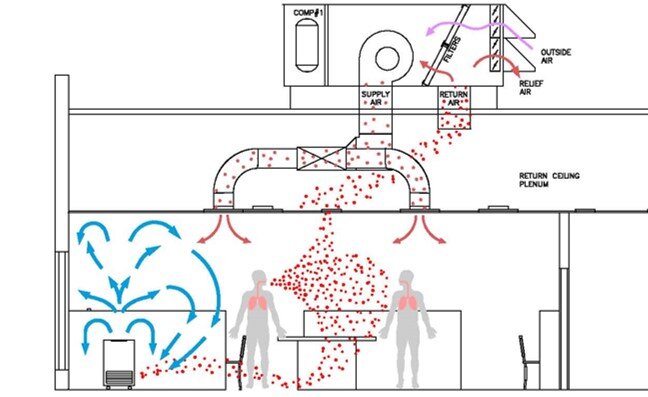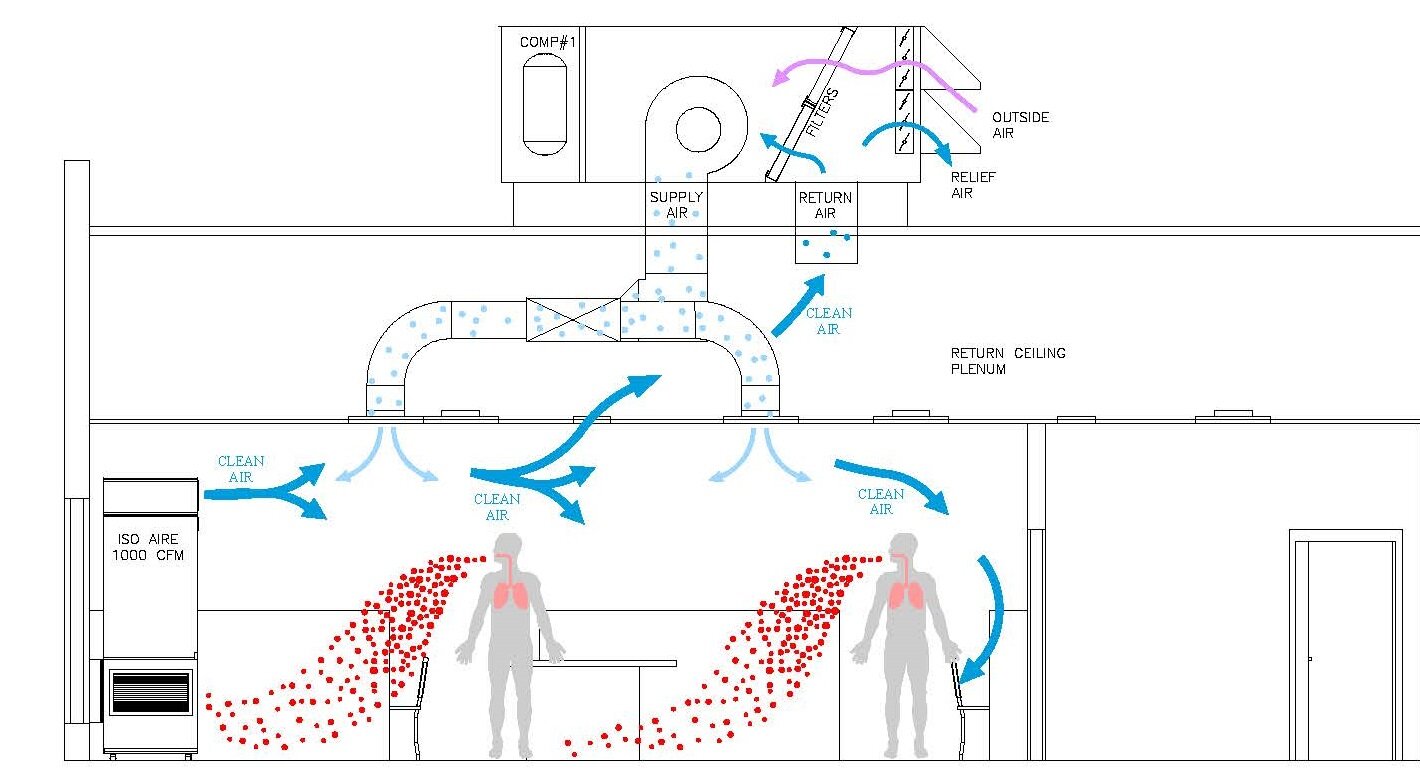Three Tips for Choosing an Effective Air Purifier
Investing in a high-quality, proven indoor air purifier for your facility is a critical decision – but choosing the right solution doesn’t have to be difficult or overwhelming. Our team of air ventilation experts and HVAC pros offer three pointers to make choosing the best commercial-grade air scrubber a breeze by comparing air throw, clean air components, and commercial-grade construction.
Powerful Air-Throw & Strategic Air-Flow Patterns
First, understand how a particular air purifier recirculates indoor air. At ISO-Aire we developed our product with an unmatched air-throw strategy, which is the method used to flood a room with clean, healthy air.
Some air purifiers create turbulence mixing clean and contaminated air together, which can be harmful for room occupants.
Some air purifiers, such as the small unit pictured to the left, create unwanted air turbulence and ineffectively mix clean and contaminated air inside a room or space. Many units only purify the air within a few feet of the unit’s location. They’re not powerful enough to continuously capture and destroy harmful airborne pathogens and pollutants throughout the room because the air-throw is limited to a small area; only those particulates within its bubble are removed.
This approach does not ensure a healthy environment, misses the mark on thorough air recirculation, and puts occupants at greater risk.
ISO-Aire pulls contaminated air away from the source and distributes clean air into the space.
In comparison, this image demonstrates an effective, safe, and continuous air flow strategy. ISO-Aire pulls air and airborne contaminants away from the source utilizing a quiet yet high-powered fan. Our recirculation models continuously capture and destroy harmful aerosolized particles and return purified air into the building environment. For example, an ISO-Aire™ RSF500 model can throw purified air a minimum of 20 and up to 100 feet for proper flow and thorough clean air distribution.
Proven Clean Air Technology
Not all HEPA filters are created equal. Our ISO-Aire units are engineered with a 12-inch deep medical-grade HEPA that captures up to 99.99% of particulates at .3 microns. Competitor HEPA filters start at 1-inch deep and require more frequent replacement.
Next, today’s smart air purifiers like ISO-Aire are manufactured with a variety of clean air components; our units combine up to three purification technologies:
HEPA filtration: tried, true, and trusted high-efficiency particulate air filters or HEPAs hold an impressive track record capturing aerosols and indoor air pollutants. Read more about their effectiveness here. In-space, HEPA purifiers are what both the Centers for Disease Control and Prevention (CDC) and ASHRAE recommend for supplemental ventilation in their COVID-19 mitigation guidance for schools and daycare centers.
UVC Sterilization: UVC – or Ultraviolet-C light – has been used and tested as an effective germicide for decades. Learn more about how it works here. The technology is highlighted in ASHRAE’s guidance for in-space purifiers given UVC “inactivates viruses and microorganisms to make them non-infectious but does not remove them from the air.” CDC’s guidance recommends UVC in schools and day care centers as supplemental clean air protection, noting that UVC “inactivates the virus that causes COVID-19, especially if options for increasing ventilation and filtration are limited.”
“It’s worth noting that the exposure rate to the UVC and intensity of the bulbs are critical,” explained Kevin Albers, ISO-Aire™ developer and sales and marketing manager. “If the UVC isn’t properly applied or if the air is moving too fast, the kill rate is greatly diminished. Our units are designed to have the right speed of airflow and UVC intensity for a high kill rate.” Albers also cautioned that exposure to UVC bulbs can be hazardous, and they should be housed safely and securely inside the unit, similar to how ISO-Aire™ HEPA air purifiers are designed.
Learn more about how bipolar ionization works from our YouTube video.
Ozone-Free Bipolar Ionization: a third layer of protection works by utilizing positive and negatively charged ions to neutralize the SARS-CoV-2 virus, emerging variants, bacteria and more. Many of our business and school partners are seeing success combining HEPA with ionization to create an effective offensive/defensive strategy to purify indoor air. some ionization designs emit ozone, so it’s very important to choose a system that utilizes ozone-free bipolar ionization technology similar to our ISO-Aire™ models.
Smart Design & Built To Last by a Team of Experts
Finally, take a look under the hood and examine how an air purifier is designed and manufactured. For example, avoid those models that use plastic parts as they can break or be damaged easily. Choose American-made products engineered by a team that stands behind each model. Other important considerations include commercial grade parts such as an ECM motor, high-performance fan, 22-gauge embossed steel enclosure, sound attenuation housing, and industrial casters.
Have questions about choosing the best air purifier to protect occupants in your indoor space? Give our team a call at 651-265-0605 via email at info@iso-aire.com.





